Table of Contents
Context: Although India has produced several influential women leaders, overall political participation among women remains low.
Women Representation in Politics 2024
- In 2024, India elected 74 female Members of Parliament (MPs) to the Lok Sabha, which is four less than in 2019. This is a decrease from the 14.4% representation in the 2019 elections. And 52 more than the number elected in the first elections in 1952.
- The 18th Lok Sabha will consist of 74 women and 469 men, which translates to only 13.6% of total MPs being women. This percentage is significantly below the 33% that will be reserved for women following the upcoming delimitation exercise.
- A total of 797 women candidates had contested the elections with the BJP fielding the maximum at 69 followed by the Congress at 41.
- India’s performance in women’s parliamentary representation is lower than many other countries, with a global average of 27.6% women elected in 2023 across 52 countries.
The political representation of women in India has been far from satisfactory.
Global Political Representation of Women
- UK: In the recent general elections, 263 women MPs (40%) were elected to the House of Commons.
- South Africa: The National Assembly has around 45% women representation.
- US: The House of Representatives has 29% women representation.
- Historical Events of Women’s Suffrage:
- New Zealand: First to grant universal women’s suffrage in 1893.
- UK: Women received the right to vote in 1928.
- US: Equal voting rights were granted through the 19th Amendment in 1920.
Trend of Women’s Representation in Lok Sabha 2024
Historical Representation
- In 1952, women constituted only 41% of Lok Sabha members.
- This figure slightly increased to over 6% in the elections a decade later but dipped below 4% in 1971, despite Indira Gandhi, India’s first female Prime Minister, being in power.
- A gradual but inconsistent rise in female representation ensued, surpassing 10% in 2009 and reaching its highest at 14.36% in 2019.
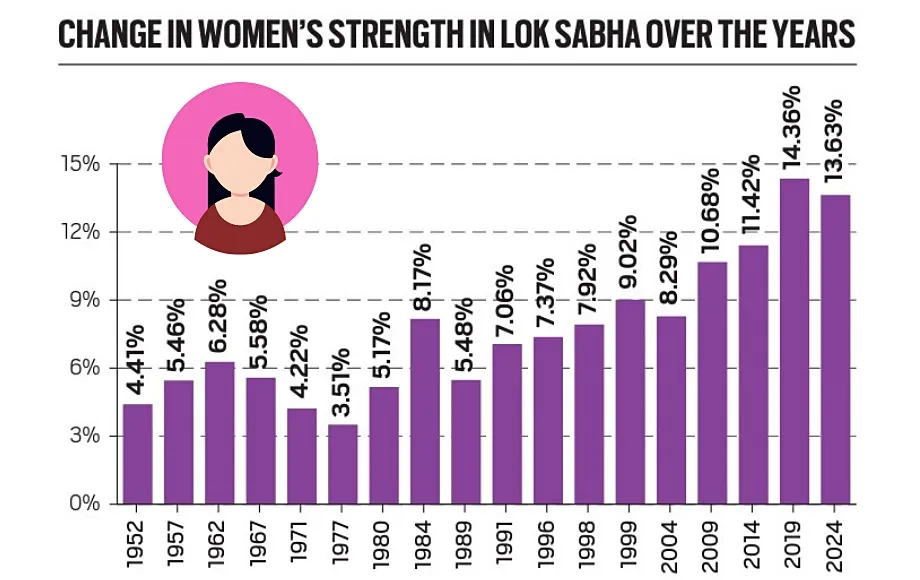
- Current Representation: In the 2024 elections, 74 women were elected to Lok Sabha, representing 13.63% of its total membership, a decrease from the previous election.
- International Comparison: India lags behind several other nations in female parliamentary representation: South Africa has 46%, the UK has 35%, and the US has 29%.
Political Party-wise Distribution of Women MP’s in 2024
Leading Parties
- Women MPs in 2024 hail from 14 different parties.
- The BJP has the highest number with 31 female MPs, followed by Congress with 13, and TMC with 11.
- Other notable contributions include SP (5), DMK (3), LJPRV (2), and JD(U) (2). Seven other parties have one female MP each.
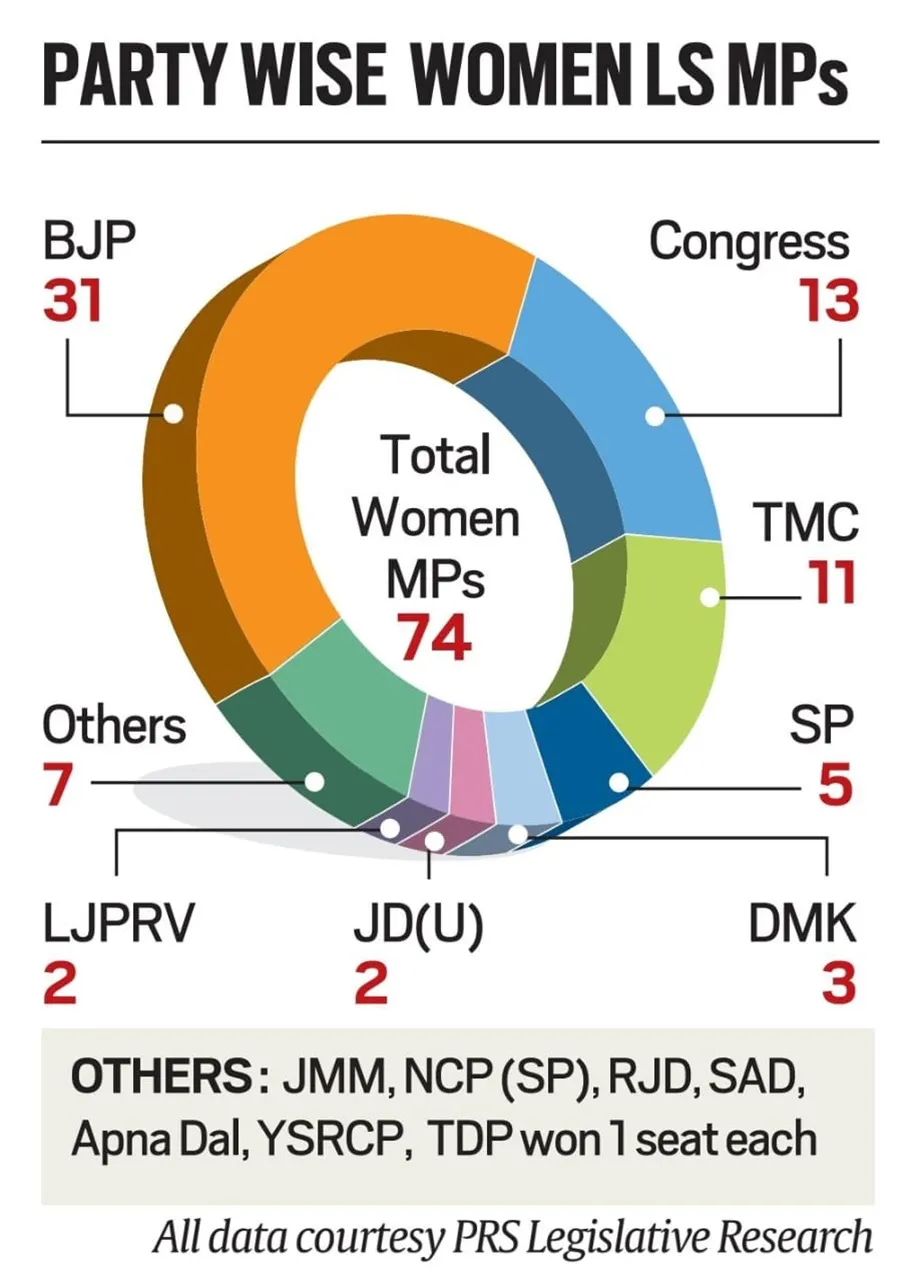
Proportional Representation
- TMC leads in proportion with 37.93% of its MPs being women.
- Congress and BJP have 13.13% and 12.92% women MPs, respectively.
Women MPs in 2024
- Out of the 74 elected women, 43 are first-time MPs.
- This ratio of newcomers (59%) is higher than the overall new MP ratio of 52% in the House.
- Women MPs have an average of 0.76 terms in the Lok Sabha.
- Demographics: The average age of women MPs is 50 years, younger than the overall average age of 56.
- They match their male counterparts in education, with 78% holding at least an undergraduate degree.
Candidates in 2024 Elections
- Participation Rate: Of the total 8,360 candidates in the 2024 elections, about 10% were women, marking the first time this proportion has been reached. This participation rate has increased from just 3% in 1957.
- Party-specific Candidate Rates: Approximately 16% of BJP’s candidates were women, compared to 13% for Congress, both of which exceed the overall average.
Women Representatives in Independent India
- Right to Vote: India granted voting rights to all women from the first general elections in 1952.
- Lok Sabha Representation:
- Low between 5% and 10% till 2004.
- Marginally increased to 12% in 2014.
- Currently stands at 14% in the 18th Lok Sabha.
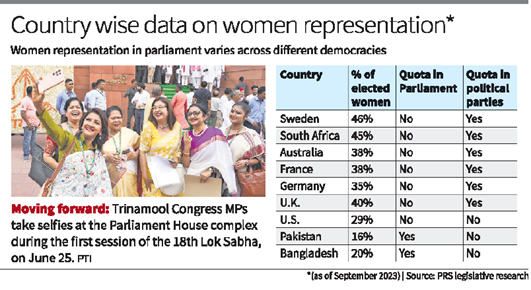
- State Legislative Assemblies: The national average representation of women is around 9%.
- 73rd and 74th Amendments (1992/1993): Provided 1/3rd reservation for women in panchayats and municipalities.
106th Constitutional Amendment
- Passed in September 2023, provides for 1/3rd reservation of seats for women in the Lok Sabha and State legislative assemblies.
- Aim: To increase gender sensitivity in parliamentary processes and legislation, and the number of women Ministers.
- Implementation: Reservation will come into effect based on the delimitation exercise after the relevant Census figures are published.
- The overdue Census since 2021 should be conducted promptly to implement the reservation by the general elections in 2029.
- Current Ranking: India ranks 143 in the ‘Monthly ranking of women in national parliaments’ by the Inter-Parliamentary Union.
Importance of Women’s Political Participation
- Advancement of Gender Equality: Women’s participation in politics is fundamental to achieving gender equality and genuine democracy.
- It facilitates women’s direct engagement in public decision-making and ensures better accountability to women.
- Improved Policy Outcomes: Women in political positions often prioritize issues such as healthcare, education, and social welfare.
- Their presence leads to more comprehensive and balanced policy decisions that address diverse societal needs.
- Enhanced Democratic Processes: Increased women’s representation strengthens democratic values by ensuring that political institutions reflect the diversity of the populations they serve.
- This inclusivity enhances the legitimacy of democratic processes and fosters greater public trust.
- Economic Growth and Development: A higher rate of women’s political representation is closely linked to legal equality and economic opportunity.
- This correlation suggests that women’s political participation can contribute to economic growth and development.
- Role Modeling and Inspiration: Women in leadership positions serve as role models, inspiring other women and girls to pursue careers in politics and leadership, thereby gradually reducing gender disparities in various sectors.
Challenges Associated with Women’s Participation in Politics
- Time Use and Care Work: Women spend up to four times more time on unpaid care work than men, limiting their ability to engage in politics.
- Social norms favour women candidates with traditional household profiles (e.g., married with children), creating additional barriers.
- Leadership Seen as a Male Domain: Patriarchal norms and rigid gender roles exclude women from formal decision-making spaces.
- Traditional contexts reinforce the idea that leadership is inherently masculine.
- Backlash, Harassment, and Violence: Smear campaigns, blackmail, and media bias undermine women politicians’ credibility and influence.
- Institutional Barriers and Political Structures: Political party structures often favour male candidates for leadership positions.
- The lack of internal party support and the absence of gender quotas reduce opportunities for women.
- Electoral financing and political networking remain male-dominated, making it harder for women to access resources.
- Societal and Cultural Norms: Deep-rooted patriarchal values discourage women from assuming leadership roles.
- Family and societal expectations often pressure women to prioritize domestic responsibilities over public life.
- Stereotypes about women’s “emotional nature” are used to undermine their political competence.
- Legal and Policy Gaps: Lack of strong legal frameworks to protect women from political violence and discrimination.
- Inadequate implementation of gender quotas and reservation policies.
- Weak political will to ensure equal representation and accountability.
| Facts |
|
How to Strengthen the Political Participation of Women
- Fund Incentivized Party Quotas: Provide financial incentives to political parties that nominate and elect women candidates.
- Example: In Georgia, political parties receive 30% more funding if at least 30% of the top 10 names on their party list are women.
- Reward parties that successfully elect women to encourage long-term change.
- Create an Enabling Environment for Voluntary Party Quotas: Encourage political parties to adopt internal gender quotas voluntarily.
- Example: In Kazakhstan, the Central Election Commission and the National Commission for Women’s Affairs endorsed recommendations for gender quotas in party charters.
- Promote government support through public statements and official guidelines.
- Enact Legislated Candidate Quotas and Reserved Seats
- Introduce legally mandated quotas or reserved seats to ensure women’s representation in political institutions.
- Example: Countries with quotas (e.g., Afghanistan, Nepal, Indonesia) have seen increased women’s representation in national and local governance.
- Support Women’s Leadership Development Programs: Implement leadership training, mentorship, and skills development programs.
- Focus on public speaking, decision-making, campaigning, and self-assertion.
- Example: Out of 41 countries in the Asia-Pacific, 20 countries reported offering such programs, including targeting minority and young women.
- Best practices include local ownership, collective approaches, and international partnerships.
- Create a Gender-Responsive Policy Environment: Monitor and revise policies to prevent gender-based discrimination and exclusion.
- Example: South Korea created a platform for citizens to report gender-discriminatory media content to tackle bias.
- Ensure Financial and Structural Support: Provide financial assistance, campaign funding, and logistical support for women candidates.
- Establish support systems like childcare, maternity and paternity leave, and networking opportunities.
- Example: In Nepal, after introducing quotas, women faced financial and management challenges, highlighting the need for ongoing training and support.
Global Methods to Increase Women Representation
- Voluntary or mandated quotas for female candidates within political parties
- Designated quotas in parliament through seat reservations
International Comparison: Mexico’s Progress
- Recent Election: Claudia Sheinbaum was elected as Mexico’s first female president in a recent election, symbolising significant progress.
- Legislative Reforms: Mexico has implemented gender parity laws requiring equal representation of women in all government spheres.
- Results: These reforms have led to gender parity in both houses of Parliament and significant female representation in major political offices.
Way Forward
- Refine Quotas: Strengthen and enforce quota systems to ensure effective representation of women in both Lok Sabha and State Assemblies.
- Public Awareness: Launch campaigns to shift perceptions on reserved quotas, highlighting the compatibility of diversity and merit.
- Constituency Stability: Implement continuous development programs that support consistency in constituency service, despite MP rotations.
- Expedite Census: Accelerate the census and delimitation processes to enable timely application of the 106th Constitutional Amendment Act.
- Evaluate Impact: Develop a framework to monitor the effects of increased women’s representation, refining policies based on these insights.
Responsibility and Action
- Need for Reform: India has seen success at increasing women’s political participation at the local level and now needs to focus on the state and national levels.
- Role of Political Parties: Political parties play a crucial role in promoting gender-sensitive reforms and ensuring women have fair opportunities to participate and be elected.
- Vigilance and Commitment Required: Continuous effort and vigilance are necessary to improve women’s representation in politics, as progress is not always linear and is never guaranteed.

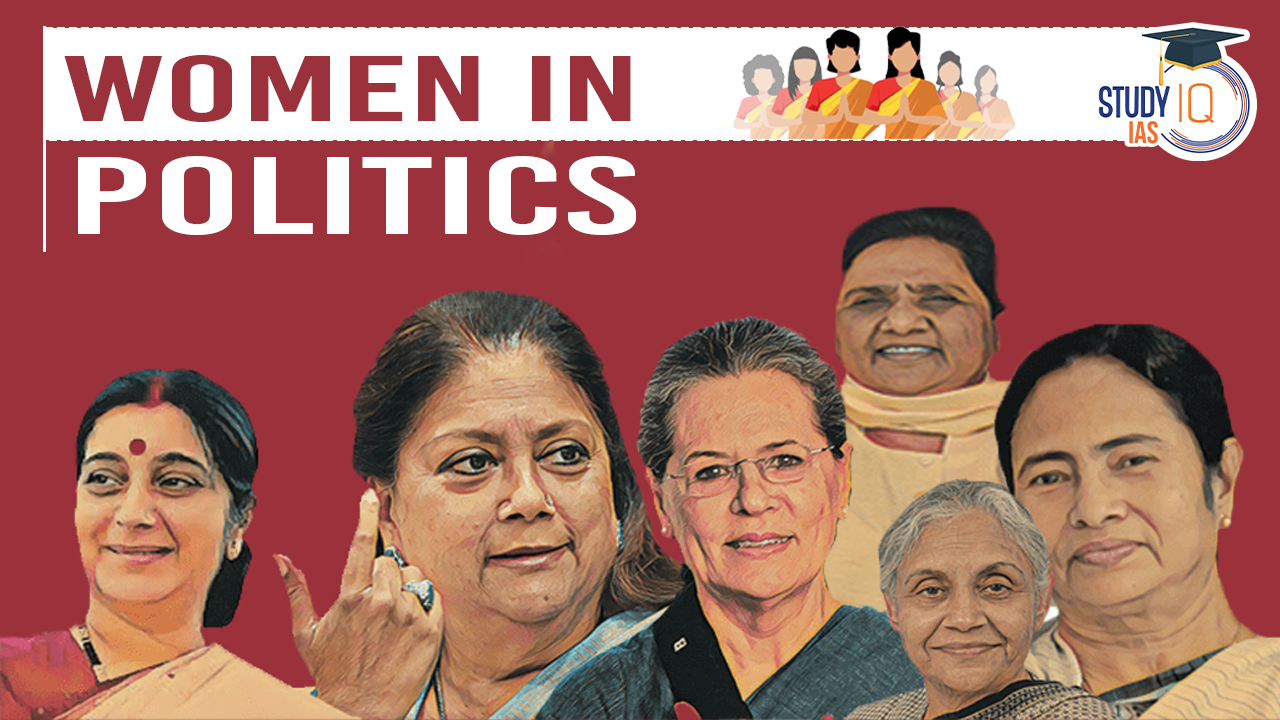
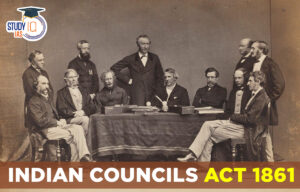 Indian Councils Act 1861, History, Provi...
Indian Councils Act 1861, History, Provi...
 New Phase of Operation Chakra to Combat ...
New Phase of Operation Chakra to Combat ...
 NITI Aayog Report on India’s Hand and ...
NITI Aayog Report on India’s Hand and ...





















